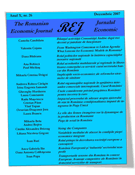Abstract:
The largest single cost of unemployment is lost production. People who cannot work do not produce—high unemployment makes the social pie smaller. Since short-run tradeoffs exist between unemployment, inflation and Gross Domestic Product growth, it is also important to get a better understanding of the relative economic costs that is involve. This study provides some input for policymakers’ evaluation of the tradeoffs. For the reason that the dynamic of output-unemployment link in Nigeria are somewhat more complicated and defile some economic theories. Thus, this paper present a ballpark methods from Okun’s law, Philips curve to Ball’s sacrifice ratio, that bear directly on measuring the short-run and long-run tradeoffs. With a sacrifice ratio of 4, that is found by this study, policymakers will have to frequently decide how hard to fight an inflationary shock, knowing that the less they accommodate, the more unemployment and less output they will achieve.
